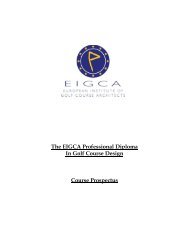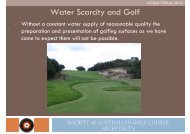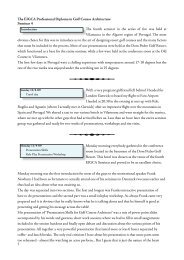Affordable Golf Facility Development - R&A Golf Course Management
Affordable Golf Facility Development - R&A Golf Course Management
Affordable Golf Facility Development - R&A Golf Course Management
- No tags were found...
You also want an ePaper? Increase the reach of your titles
YUMPU automatically turns print PDFs into web optimized ePapers that Google loves.
<strong>Affordable</strong> <strong>Golf</strong> <strong>Facility</strong> <strong>Development</strong>:Growing the Game
• pitch and putt and par 3 courses. These can be laid out onan existing, relatively small area of grassland, perhaps nomore than 10 to 15 hectares, with tees, fairways and greensproduced by simply mowing the grass closer (picturedbelow). Purpose-built facilities can be developed, but atmuch greater cost. This type of course requires relativelylittle land. They can provide an enjoyable way for newcomersto experience a real course. They can also test and improvethe short game of experienced golfers.All of the above can be built relatively cheaply and do not requirelarge areas of land. Indeed, the few hectares needed for suchdevelopments means that they may be suited to brown field sites,which will provide a golf facility within reach of a large number ofpeople. These forms of golf are not time consuming; anyone withan hour or two to spare can enjoy a practice session at a drivingrange or a round on a pitch and putt course.• 3, 6 or 9 hole courses provide a true golf experience on asmaller area of land than required by a full 18 holes. Thisreduced number of holes can also be applied to pitch andputt and par 3 courses. These courses give the golfer optionsto maximise their free time for golf• short-length 18 hole courses. The wonderful course at Rye,in East Sussex, England (pictured below), is only 6,497 yardsand has a par of just 68, yet it jointly hosted the EnglishAmateur Championship in 2009• full-length 18 hole courses which can require 60 hectares ormore of land.Building full-length courses may meet some of the demands ofa mature golf market. However, pressures of time and family lifeoften mean golfers struggle to regularly play a round which maytake 4 to 5 hours. For an immature or growing market, practicefacilities and shorter versions of the sport provide a conveniententry point and facilities that will also benefit experienced golfers.<strong>Golf</strong> facilities that take up less space are also ideal where land is ata premium. They also cost less to build and maintain, utilising fewernatural resources such as water.Key elements to golf developmentThere are certain essential matters to consider before starting anygolf course development which will have major implications for thesuccess of the venture:• the need to undertake a financial feasibility study todetermine the cost of the development (including land), theneeds of the market and the suitability of the location forthat market• the need to undertake a technical feasibility study of the sitein question to determine its suitability for the project and thelikely requirements for earth movement, drainage, irrigationand the most suitable grass selection. Site selection is oneof the most important factors which determines the cost ofdeveloping a course• the need to undertake a sustainability impact assessment onthe environmental and social implications of the development.To guarantee the success of any project, it is important to:Feasibility studies require on site inspection• use qualified experts. A golf course architectural practicewhich has demonstrated an ability to design with economyand sustainability in mind will normally be the key adviser toa project but agronomists, irrigation consultants and drainageconsultants are likely to be required depending upon the sitecharacteristics and the scale of the project• choose the right site• fit the design to the site, utilising existing terrain, vegetationand infrastructure (such as buildings) where feasible. RoyalBirkdale, shown right, is a great example of a course that‘fits’ into the natural landscape and makes the most ofnative vegetationPar 3 course• choose the right grasses and other plants for the site, itsclimate and available resources• source materials of suitable quality for the development,including water and soilsThe 12th at Birkdale, sitting into the dune landscape• implement the necessary standard of construction, includingearthworks, drainage and irrigation provisionRye6 The R&A – <strong>Affordable</strong> <strong>Golf</strong> <strong>Facility</strong> <strong>Development</strong> 7
• employ a design, build and maintenancemodel that makes optimum use of localresources, including water, labour, suppliers,energy and waste managementSelecting a site for a golf courseThe best sites on which to build a golf course will have a numberof attributes:• employ a design that is reasonablymaintenance-friendly, to suit ease of mowingand other practices. Intricate bunker designwill be labour intensive; studies have shownthat up to 27% of maintenance time can bespent managing such hazards!• affordable. Land prices will vary greatly dependent on location• good location. Close to large centres of population andinfrastructure. A good road network and, therefore, proximityto utilities and local sources of materials, will make the coursemore accessible and easier and cheaper to build• be aware of the grow in and ongoingmaintenance requirements to be sure thedevelopment is affordable to manage overthe long-term.More information can be found at The <strong>Golf</strong> <strong>Course</strong><strong>Management</strong> section of The R&A website, www.RandA.org andGEO Legacy www.golfenvironment.org/legacyDigging drains, Malaysia• good topography. Interesting contours into which a golfcourse can sit. If earthworks have to be extensive to create agolf course, this will be expensive and will increase the needfor drainage. Rocky sites will be expensive to develop• good drainage. A dry facility will increase revenue potentialby being available for play more than a wet course. Gooddrainage will help the promotion of firm and healthy turfPoor drainage reduces potential revenueHigh-maintenance bunker• good water supply. This applies to quantity and quality.Ideally, clean fresh water will be available in large enoughquantities to water in-play areas during prolonged periods ofdry weather. Drought-tolerant grasses can reduce the needfor water, but not eliminate it entirely. Alternative sources topotable water should be sourced, for socio-political reasons,but provision of recycled, harvested or desalinated supplieswill add to the development and running costs of the project• good climate. Not too dry, not too wet, not too hot andnot too cold! Grass selection, drainage and irrigation cancompensate for climatic extremes to a degree but climateswith extremes beyond the natural capacity of turfgrasses willincur great cost• good labour. It is necessary to have suitably qualified people,as well as sufficient numbers, to ensure the sustainabledevelopment and management of a golf facility.Any site not blessed with ideal attributes will incur greater costs toconstruct and manage and could struggle to attract enough golfersto make it viable.Water storage in a dry climate8 The R&A – <strong>Affordable</strong> <strong>Golf</strong> <strong>Facility</strong> <strong>Development</strong> 9
Victoria <strong>Golf</strong> & Country Club, Kandy, Sri LankaThe Victoria <strong>Golf</strong> & Country Club was established in 1999 on apeninsular jutting out into the Victoria Reservoir near Kandy, SriLanka. The land was formerly an estate where mixed farming waspractised – livestock, coconuts, peppers and fruits were farmed onthe estate. The course is parkland in nature and contains a largeelevation change on the front nine holes and attractively undulatingcontours for the back nine. Some of the back nine holes run closeto the reservoir boundary. When the water level is at full supplythe water comes right up to the fairways but it can drop by anamazing 80m during drought periods! The project has a residentialcomponent with house plots developed around the course andthere is a hotel site which, as yet, remains undeveloped. Despitethe very low cost of construction of the course, it has been votedthe Best <strong>Course</strong> On The Sub-Continent in 2004, 2008, 2009 and2011 by the readers of Asian <strong>Golf</strong> Monthly.The method of constructionThe course was constructed on a project managed basis. Locallabour and machinery was used almost entirely to build thecourse. The only outside assistance was in the form of visits bythe golf course architect, the presence of a shaper for 8 weeks(who taught the project manager how to set out the green levelsand a local machine operator how to shape the greens) and anirrigation installer.Victoria <strong>Golf</strong> Club, Sri LankaTeeing off at VictoriaThe cost of course constructionThe cost of construction of the 18 holes and practice ground wasin the region of £410,000. This is the cost of just one hole onsome projects!How was the course built so affordably?The course design• The course was designed to respect the natural contours.Although some earth was moved, the quantity was tinycompared with many courses.• Only 12 relatively small bunkers were designed for thecourse. This was possible as a result of the wonderfulnatural features of trees and rock outcrops making any morebunkers unnecessary.Taking advantage of native vegetation16 The R&A – <strong>Affordable</strong> <strong>Golf</strong> <strong>Facility</strong> <strong>Development</strong>17
Specification of construction• The very good, sandy, local soil was used for fairwaysand tees.• Sand and gravel sourced from nearby local rivers wasused for the green construction. One type of material wasimported and graded on site to produce the gravel and sand.• Locally sourced coconut peat was used for the organicmatter component of the green root zone.• An automatic irrigation system was installed to tees, greensand approaches only. Hose points were installed to irrigatefairways. It would be good to have automatic fairwayirrigation but this project shows that even in tropicalwarm season climates it is not essential, provided there isadequate labour.Method of constructionUtilising so much local labour and machinery on a project managedbasis restricted costs significantly. In the Sri Lankan labour market,where costs are so low, many tasks normally carried out bymachine were carried out by hand. This included cutting out ofdrain lines and placement of all of the materials on the greens forinstance. All planting of the Bermudagrass stolons was carried outby hand.Growing in at Victoria<strong>Affordable</strong> <strong>Golf</strong> <strong>Facility</strong> <strong>Development</strong>: SummaryFor the game of golf to grow sustainably it must:• work within local, national and regional frameworks with regard to demand and potentialfor growth• identify the potential golfing population, be that indigenous and/or tourist• encourage the development of appropriate facilities to cater for that golfing population• consider the future development of the golfing population to ensure the provision of facilities isflexible enough to cope with a maturing market.ReferencesThe R&A website, www.RandA.orgGEO Legacy, www.golfenvironment.org/legacyPhoto creditsPaolo Croce, Martin Ebert, St Andrews Links Trust, Erich Steiner, The R&AClubhouse facilitiesThe clubhouse made use of some existing buildings on the site.Their conversion cost a very low amount of money. Over time theclubhouse has been extended as use of the golf course has grown.Local Sri Lankan labour18 The R&A – <strong>Affordable</strong> <strong>Golf</strong> <strong>Facility</strong> <strong>Development</strong>October 2012This publication has been printed on environmentallyfriendly material from well-managed sources











